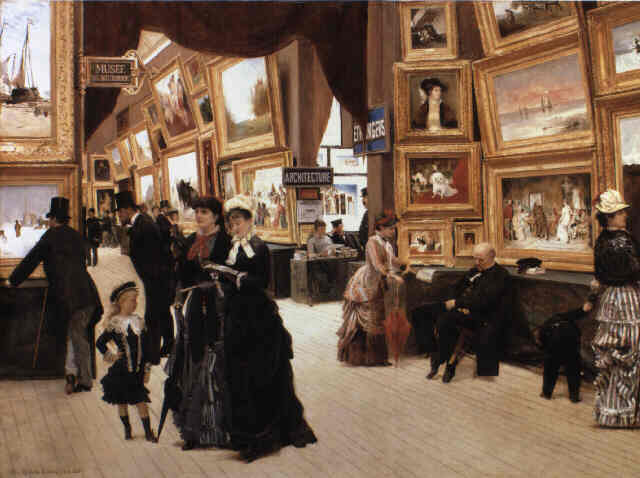The Dealer-Critic System
Harrison C. White and Cynthia A. White, Canvases and Careers: Institutional Change in the French Painting World (Chicago: University of Chicago Press, 1993), pp.94-
In their classic (1965) study of the changes in the world of French painting in the 19th century, sociologists Harrison and Cynthia White focused on the ways in which dealers and critics began to provide artists with a means of reaching the public without having to accept the stylistic restrictions imposed by the Academy. As you read their description below, think about the ways that the existence of dealers and critics could give young artists an opportunity to experiment with new styles that Academy disapproved of.
A much larger market for paintings was needed and could be mobilized in the nineteenth century. The dealers recognized, encouraged, and catered to new social markets,
Édouard Dantan, A Corner of the Salon in 1880 |
which, although diverse in artistic focus, when cumulated could expand greatly the total market. We use the term "social market" because the existence of a demand for current artistic production of a given type depended more on the existence of a favorable climate of opinion than on prices. The demand for an individual painter's works depended, similarly, on the several circles of art opinion. The Salon and official recognition of other kinds were crucial elements in establishing creative renown, but it was the critics in conjunction with the dealers who accomplished the detailed task of building up an artist in a specific circle of patrons. Dealers and critics, once subsidiaries to the Academic system, grew in numbers and independence. This growth was a response to the very success of the official system in recruitment of painters, and to the increased public interest which had been generated by the publicity and attention given to art by the state.
Dispersion of buying power was a central reality of the new situation to which the dealer-critic system could adapt much more effectively than the centralized official machine. There was no question of a mass market in the modern American sense, but neither was the total requisite support attainable from a series of major private patrons plus a central government apparatus for awarding commissions. There were enough, and sufficiently varied, potential buyers so that one had to think in terms of markets rather than individuals. As Charles Blanc put it, under a despotic state art flourishes because of the immense concentration of wealth, whereas in a democratic state "To link together men, to group together wealth, to reunite so many dispersed resources -- these are the future conditions for the prosperity of art and its expansion."
One basic need of the emerging system based on dealers and critics was to create an ideology and an organization which would jibe with the accepted "pure" painter role, while allowing an alliance with painters who needed the financial framework dealers could provide. Naturally, the dealers' primary purpose was to find
a way to profit from the larger market that could be opened up, and the critic was interested in establishing his reputation as an influential intellectual.
The dealer who bought or exhibited some works of a young, unknown painter was speculating for his own profit; but he was at the same time awarding a prize akin to a "medal of encouragement" or honorable mention. The dealer who supported a painter with a monthly "salary" in return for promised works was emulating the old patronage system, as well as Academic fellowships like the Prix de Rome. The critics' development of the"unknown genius" ideology was an ingenious variation of, but in harmony with, the "pure" painter, man-of-learning theme of the Academy. It was also a natural outgrowth of the changes in roles that we noted as emerging early in the nineteenth century, principally during the Romantic Period. . . .
Few even of the other critics would have regarded themselves as participants in a new dealer-critic system that was to control the art world. As Sloane emphasized, there were several schools of critics espousing different ideologies, which often had little relation to the actual developments in French painting. Nonetheless, in our view the critics did function as part of a new system, willy-nilly. Only 14 per cent were painters (less than half Academicians) and at most a further 10 per cent, those in government jobs dealing with current art, could be regarded as an integral part of the Academic institutional system. The critics wrote about Salons and the Prix de Rome competitors, the official occasions of recognition, but they also wrote throughout the year about sales, group shows, dealer shows, and so on. Whether they praised or castigated, the critics publicized the calendar of events, the dealers, painters, and the works of art, informing a large readership of this extra·Academic activity.
